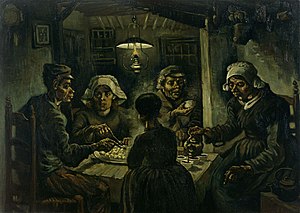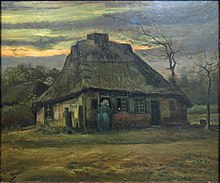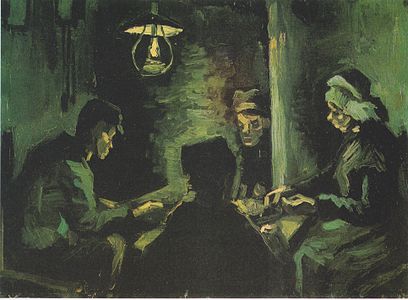Painting by Vincent van Gogh
| The Potato Eaters | |
|---|---|
| Dutch: De Aardappeleters | |
 | |
| Artist | Vincent van Gogh |
| Year | 1885 |
| Catalogue | |
| Medium | Oil on canvas |
| Dimensions | 82 cm × 114 cm (32.3 in × 44.9 in) |
| Location | Van Gogh Museum, Amsterdam |
The Potato Eaters (Dutch: De Aardappeleters) is an oil painting by Dutch artist Vincent van Gogh painted in April 1885 in Nuenen, Netherlands.
It is in the Van Gogh Museum in Amsterdam. The original oil sketch is at the Kröller-Müller Museum in Otterlo, and he made lithographs of the image, which are held in collections including the Museum of Modern Art in New York City. The painting is considered to be one of Van Gogh's masterpieces.
Composition

During March and the beginning of April 1885, Van Gogh sketched studies for the painting and corresponded with his brother Theo, who was not impressed with his current work nor the sketches Van Gogh sent him in Paris. He began working on The Potato Eaters while living with his parents in Nuenen, a rural town which was home to many farmers, labourers and weavers. He worked on the painting from 13 April until the beginning of May, when it was mostly done except for minor changes that he made with a small brush later the same year.
Van Gogh said he wanted to depict peasants as they really were. He deliberately chose coarse and ugly models, thinking that they would be natural and unspoiled in his finished work.
Writing to his sister Willemina two years later in Paris, Van Gogh still considered The Potato Eaters his most successful painting: "What I think about my own work is that the painting of the peasants eating potatoes that I did in Nuenen is after all the best thing I did". However, the work was criticized by his friend Anthon van Rappard soon after it was painted. This was a blow to Van Gogh's confidence as an emerging artist, and he wrote back to his friend, "you... had no right to condemn my work in the way you did" (July 1885), and later, "I am always doing what I can't do yet in order to learn how to do it." (August 1885).
Vincent Van Gogh is known to have admired the Belgian painter Charles de Groux and in particular his work The blessing before supper. De Groux's work is a solemn depiction of a peasant family saying grace before supper. The painting was closely linked to Christian representations of the Last Supper. Van Gogh's The Potato Eaters was inspired by this work of de Groux and similar religious connotations can be identified in Van Gogh's work.
Versions
-
Second Study for The Potato Eaters, 1885, Kröller-Müller Museum, Otterlo
-
 Study for The Potato Eaters, 1885, Private collection (F77r)
Study for The Potato Eaters, 1885, Private collection (F77r)
-
 Study for The Potato Eaters
Study for The Potato Eaters
Lithograph

Van Gogh made a lithograph of the composition The Potato Eaters before embarking on the painting proper. He sent impressions to his brother and, in a letter to a friend, wrote that he made the lithograph from memory in the space of a day.
Van Gogh had first experimented with lithography in The Hague in 1882. Though he appreciated small scale graphic work and was an enthusiastic collector of English engravings he worked relatively little in graphic mediums. In a letter dated around 3 December 1882 he remarks
I believe, though, that it would be a great mistake to imagine that such things as, for instance, the print The Grace (a family of woodcutters or peasants at table) were created at a stroke in their final form. No, in most cases the solidity and pith of the small is only obtained through much more serious study than is imagined by those who think lightly of the task of illustrating ... Anyway, some paintings in their huge frames look very substantial, and later one is surprised when they actually leave behind such an empty and dissatisfied feeling. On the other hand, one overlooks many an unpretentious woodcut or lithograph or etching now and then, but comes back to it and becomes more and more attached to it with time, and senses something great in it.
Influence of the Hague School
Van Gogh is often associated in people's minds with the Post-Impressionist movement, but in fact his artistic roots lay much closer to home in the artists of the Hague School such as Anton Mauve and Jozef Israëls.
In a letter to his brother Theo written mid-June 1884, Vincent remarks:
When I hear you talk about a lot of new names, it's not always possible for me to understand when I've seen absolutely nothing by them. And from what you said about 'Impressionism', I’ve grasped that it's something different from what I thought it was, but it's still not entirely clear to me what one should understand by it. But for my part, I find so tremendously much in Israëls, for instance, that I'm not particularly curious about or eager for something different or newer.
Before Vincent painted The Potato Eaters, Israëls had already treated the same subject in his A Peasant Family at the Table and, judging from a comment in a letter to Theo 11 March 1882, Vincent had seen this (or at least a variation of it) and had been inspired to produce his own version of it. Compositionally, the two are very similar: in both paintings the composition of the painting is centered by a figure whose back is turned to the viewer.
As well as an interest gained by A Peasant Family at the Table, Vincent had an appreciation for a simpler lifestyle. Vincent was known to disregard the finer things, once writing in a letter to his brother Theo:
When I receive money, even if I've fasted, isn't for food, but is even stronger for painting meanwhile the lifeline I cling to is my breakfast with the people where I live, and a cup of coffee and bread in the cremerie in the evening...
Van Gogh seemed to emotionally identify with the middle class, although he was from a family who were quite well-off. The subject was that of the harsh reality of life in the working class. He also simply admired the sustainability of the potato, or aardappel in Dutch. Aardappel literally translates to "earth apple," which paints an idea of a simpler, hearty lifestyle.
Theft
Thieves stole the early version of The Potato Eaters, the Weaver's Interior, and Dried Sunflowers from the Kröller-Müller Museum in December 1988. In April 1989, the thieves returned Weaver's Interior in an attempt to gain a $2.5 million ransom. The police recovered the other two on 14 July 1989; no ransom was paid.
On 14 April 1991, the Vincent van Gogh National Museum was robbed of twenty major paintings including the final version of The Potato Eaters. However, the getaway car suffered a blown tire, and the thieves were forced to flee, leaving the paintings behind. Thirty-five minutes after the robbery, the paintings were recovered.
See also
References
- van Tilborgh, Louis (2009). "The Potato Eaters by Vincent van Gogh". The Vincent van Gogh Gallery. Retrieved 11 September 2009.
- Crispino 2008, p. 1885.
- "The Cottage, 1885". Permanent Collection. Van Gogh Museum. 2005–2011. Retrieved 15 May 2011.
- Naifeh & Smith 2011, pp. 439–40
- Magazine, Smithsonian; Katz, Brigit. "The Untold Story of van Gogh's Once-Maligned Masterpiece, 'The Potato Eaters'". Smithsonian Magazine. Retrieved 29 July 2023.
- "Vincent van Gogh - The Potato Eaters". Van Gogh Museum. Retrieved 29 July 2023.
- "Letter 497". Vincent Van Gogh. The Letters. Amsterdam: Van Gogh Museum.
- McQuillan 1989, p. 38
- McQuillan 1989, p. 20
- Jared Baxter Davidson, Van Gogh's Last Supper: Transforming the guise of observable reality, in: Anistoriton Journal, vol. 14 (2014 ‐ 2015)
- Chris Stolwijk, Sjraar van Heugten, Leo Jansen, Nienke Bakker, Van Gogh's imaginary museum: exploring the artist's inner world, Harry N. Abrams, Inc., 2003
- "Letter 516: To Anthon van Rappard. Nuenen, on or about Wednesday, 15 July 1885". Vincent van Gogh. The Letters. Amsterdam: Van Gogh Museum.
- "Graphic work of Vincent van Gogh". The Vincent van Gogh Gallery. Retrieved 23 August 2010.
- "Letter 290". Vincent van Gogh. The Letters. Amsterdam: Van Gogh Museum.
- "Letter 450". Vincent van Gogh. The Letters. Amsterdam: Van Gogh Museum.
- "Van Gogh Museum - A Peasant Family at the Table". Vangoghmuseum.nl. Archived from the original on 1 April 2013. Retrieved 25 September 2018.
- "Letter 211". Vincent van Gogh. The Letters. Amsterdam: Van Gogh Museum.
- "Thieves Return One Of 3 Stolen Van Goghs". The New York Times. Associated Press. 17 April 1989.
- Haden, Anthony (28 February 2001). "Great Art Thefts Of The 20th Century". Forbes. Retrieved 21 September 2015.
- "6 Perfect Crimes That Got Foiled By Stupid Accidents". Cracked.com. Retrieved 9 May 2018.
- "Police Say Robbery of 20 Van Goghs Was Inside Job". AP News. Retrieved 9 May 2018.
- Paul L. Montgomery (15 April 1991). "Lost and Found: Huge van Gogh Theft Fails - New York Times". The New York Times. Amsterdam (Netherlands). Retrieved 25 June 2014.
Sources
- Crispino, Enrica (2008). Van Gogh. The Oliver Press, Inc. ISBN 978-1934545058.
- McQuillan, Melissa (1989). Van Gogh. London: Thames and Hudson. ISBN 1-86046-859-4.
- Naifeh, Steven; Smith, Gregory White (2011). Van Gogh: The Life. New York: Random House. ISBN 978-0-375-50748-9.
Further reading
- de la Faille, Jacob Baart (1970). The works of Vincent van Gogh (3rd ed.). Amsterdam: Meulenhoff. OCLC 300160639.
- Hulsker, Jan (1986). The Complete Van Gogh: Paintings, Drawings, Sketches. New York, NY: Harrison House/Harry N. Abrams Distributed by Crown Publishers, Random House. ISBN 0-517-44867-X.
External links
- Van Gogh, paintings and drawings: a special loan exhibition, a fully digitized exhibition catalog from The Metropolitan Museum of Art Libraries, which contains material on this painting (see index)
- The Potato Eaters (1885), oil on canvas, Van Gogh Museum, Amsterdam
- The Potato Eaters (1885), oil on canvas, Kröller-Müller Museum, Otterlo
- [REDACTED] Media related to The Potato Eaters at Wikimedia Commons